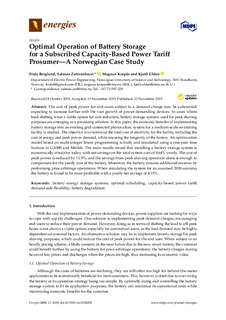| dc.contributor.author | Berglund, Frida | |
| dc.contributor.author | Zaferanlouei, Salman | |
| dc.contributor.author | Korpås, Magnus | |
| dc.contributor.author | Uhlen, Kjetil | |
| dc.date.accessioned | 2019-11-25T11:42:09Z | |
| dc.date.available | 2019-11-25T11:42:09Z | |
| dc.date.created | 2019-11-22T11:39:19Z | |
| dc.date.issued | 2019 | |
| dc.identifier.citation | Energies. 2019, 12 (23) | nb_NO |
| dc.identifier.issn | 1996-1073 | |
| dc.identifier.uri | http://hdl.handle.net/11250/2630254 | |
| dc.description.abstract | The cost of peak power for end-users subject to a demand charge may be substantial, expecting to increase further with the vast growth of power-demanding devices. In cases where load-shifting is not a viable option for cost reduction, battery storage systems used for peak shaving purposes are emerging as a promising solution. In this paper, the economic benefits of implementing battery storage into an existing grid-connected photovoltaic system for a medium-scale swimming facility is studied. The objective is to minimize the total cost of electricity for the facility, including the cost of energy and peak power demand, while ensuring the longevity of the battery. An optimization model based on multi-integer linear programming is built, and simulated using a one-year time horizon in GAMS and Matlab. The main results reveal that installing a battery storage system is economically attractive today, with net savings on the total system cost of 0.64% yearly. The cost of peak power is reduced by 13.9%, and the savings from peak shaving operation alone is enough to compensate for the yearly cost of the battery. Moreover, the battery ensures additional revenue by performing price arbitrage operations. When simulating the system for an assumed 2030 scenario, the battery is found to be more profitable with a yearly net savings of 4.15%. | nb_NO |
| dc.language.iso | eng | nb_NO |
| dc.publisher | MDPI | nb_NO |
| dc.rights | Navngivelse 4.0 Internasjonal | * |
| dc.rights.uri | http://creativecommons.org/licenses/by/4.0/deed.no | * |
| dc.title | Optimal Operation of Battery Storage for a Subscribed Capacity-Based Power Tariff Prosumer—A Norwegian Case Study | nb_NO |
| dc.type | Journal article | nb_NO |
| dc.type | Peer reviewed | nb_NO |
| dc.description.version | publishedVersion | nb_NO |
| dc.source.volume | 12 | nb_NO |
| dc.source.journal | Energies | nb_NO |
| dc.source.issue | 23 | nb_NO |
| dc.identifier.doi | 10.3390/en12234450 | |
| dc.identifier.cristin | 1750912 | |
| dc.description.localcode | © 2019 by the authors. Licensee MDPI, Basel, Switzerland. This article is an open access article distributed under the terms and conditions of the Creative Commons Attribution (CC BY) license (http://creativecommons.org/licenses/by/4.0/). | nb_NO |
| cristin.unitcode | 194,63,20,0 | |
| cristin.unitname | Institutt for elkraftteknikk | |
| cristin.ispublished | false | |
| cristin.fulltext | postprint | |
| cristin.qualitycode | 1 | |

